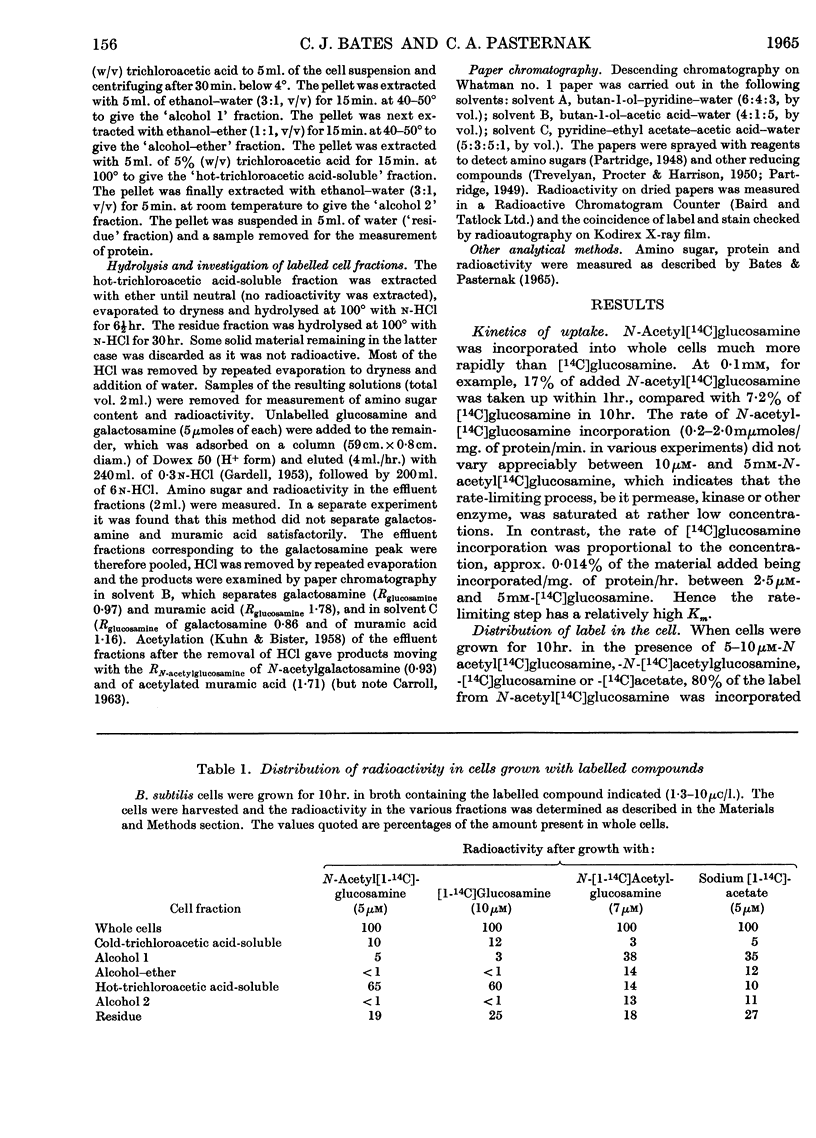Abstract
1. N-Acetyl[1-14C]glucosamine (10μm–5mm) is incorporated by cells of Bacillus subtilis at a constant rate (0·2–2mμmoles/mg. dry wt./hr.). The rate of [1-14C]glucosamine (2·5μm–5mm) incorporation is proportional to the concentration; it approaches that of N-acetyl[1-14C]glucosamine at 5mm. 2. Label from N-acetyl-[1-14C]glucosamine and [1-14C]glucosamine is incorporated predominantly into the `hot-trichloroacetic acid-soluble' and `residue' fractions of cells. Acid hydrolysis of the hot-trichloroacetic acid-soluble fraction yields mainly [14C]glucosamine; hydrolysis of the residue fraction yields [14C]glucosamine and [14C]muramic acid. The label from N-[1-14C]acetylglucosamine and sodium [1-14C]acetate enters most cell fractions. Incorporation of N-[1-14C]acetylglucosamine is inhibited by the addition of unlabelled acetate. 3. Glucose competes with [1-14C]glucosamine for incorporation. N-Propionylglucosamine and N-formylglucosamine compete with N-acetyl[1-14C]glucosamine. 4. Cells pregrown on N-acetylglucosamine or glucosamine incorporate up to ten times as much N-acetyl[1-14C]glucosamine or [1-14C]glucosamine in a given time as cells pregrown on glucose.
Full text
PDF



Selected References
These references are in PubMed. This may not be the complete list of references from this article.
- BATES C. J., PASTERNAK C. A. FURTHER STUDIES ON THE REGULATION OF AMINO SUGAR METABOLISM IN BACILLUS SUBTILIS. Biochem J. 1965 Jul;96:147–154. doi: 10.1042/bj0960147. [DOI] [PMC free article] [PubMed] [Google Scholar]
- CLARKE J. S., PASTERNAK C. A. The regulation of amino sugar metabolism in Bacillus subtilis. Biochem J. 1962 Jul;84:185–191. doi: 10.1042/bj0840185. [DOI] [PMC free article] [PubMed] [Google Scholar]
- DORFMAN A. Metabolism of the mucopolysaccharides of connective tissue. Pharmacol Rev. 1955 Mar;7(1):1–31. [PubMed] [Google Scholar]
- GLASER L. The biosynthesis of N-acetylgalactosamine. J Biol Chem. 1959 Nov;234:2801–2805. [PubMed] [Google Scholar]
- JANCZURA E., PERKINS H. R., ROGERS H. J. Teichuronic acid: a mucopolysaccharide present in wall preparations from vegetative cells of Bacillus subtilis. Biochem J. 1961 Jul;80:82–93. doi: 10.1042/bj0800082. [DOI] [PMC free article] [PubMed] [Google Scholar]
- MAGASANIK B. Catabolite repression. Cold Spring Harb Symp Quant Biol. 1961;26:249–256. doi: 10.1101/sqb.1961.026.01.031. [DOI] [PubMed] [Google Scholar]
- Partridge S. M. Filter-paper partition chromatography of sugars: 1. General description and application to the qualitative analysis of sugars in apple juice, egg white and foetal blood of sheep. with a note by R. G. Westall. Biochem J. 1948;42(2):238–250. doi: 10.1042/bj0420238. [DOI] [PMC free article] [PubMed] [Google Scholar]
- ROBERTS J., JOHNSON M. J. Effect of penicillin on the cell wall of Bacillus subtilis. Biochim Biophys Acta. 1962 May 21;59:458–466. doi: 10.1016/0006-3002(62)90196-8. [DOI] [PubMed] [Google Scholar]
- SHARON N. Polysaccharide containing amino-sugar from Bacillus subtilis. Nature. 1957 May 4;179(4566):919–919. doi: 10.1038/179919a0. [DOI] [PubMed] [Google Scholar]
- STRANGE R. E., POWELL J. F. Hexosamine-containing peptides in spores of Bacillus subtilis, B. megatherium and B. cereus. Biochem J. 1954 Sep;58(1):80–85. doi: 10.1042/bj0580080. [DOI] [PMC free article] [PubMed] [Google Scholar]
- TREVELYAN W. E., PROCTER D. P., HARRISON J. S. Detection of sugars on paper chromatograms. Nature. 1950 Sep 9;166(4219):444–445. doi: 10.1038/166444b0. [DOI] [PubMed] [Google Scholar]
- YOUNG F. E., SPIZIZEN J., CRAWFORD I. P. BIOCHEMICAL ASPECTS OF COMPETENCE IN THE BACILLUS SUBTILIS TRANSFORMATION SYSTEM. I. CHEMICAL COMPOSITION OF CELL WALLS. J Biol Chem. 1963 Sep;238:3119–3125. [PubMed] [Google Scholar]


